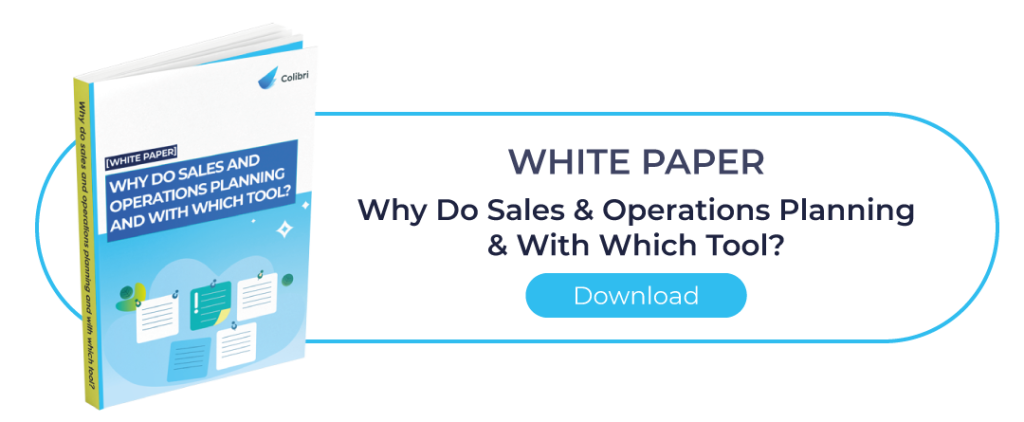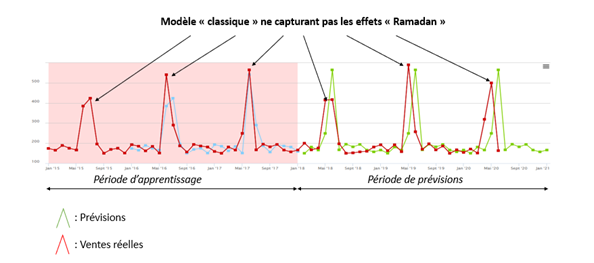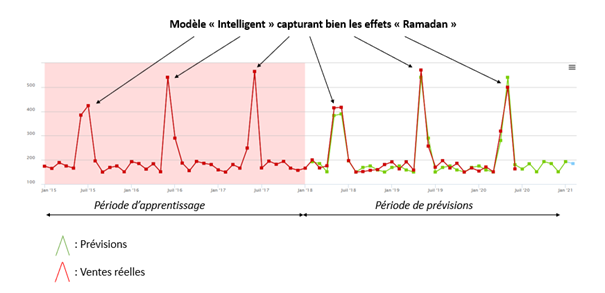Forecasting sales is more challenging for companies when there is non-recurring seasonality. Intelligent solutions such as COLIBRI help you calculate your forecasting even when the events that impact sales do not co-occur from one year to the next. Here’s how it works.
Non-repetitive seasonality: what is it?
Today, forecasting algorithms and methods are based on a seasonality linked to the European Gregorian calendar. The latter has 365 days, 12 months per year… and events that are reproducible over time. Also, many events always occur on the same date. This is particularly true of Valentine’s Day, Christmas, and New Year’s Day.
Other sales are linked to events that differ from year to year, such as Ramadan. Indeed, this festival does not occur on a precise date or at a specific and repetitive period from a calendar point of view. Its data and seasonality fluctuate from year to year.
Other events are not reproducible: school holidays, for example, whose dates vary each year depending on the zone. The same applies to unavoidable circumstances, such as trade fairs or sports championships, where the date undoubtedly goes each year.
In these cases, where sales schedules and forecasts are not identically reproducible, this is known as “non-repeatable seasonality“.
Which companies are subject to non-repetitive seasonality?
Currently, many companies are confronted with this phenomenon. This is the case, for example, for food companies that sell halal products or export to Muslim countries. Sports companies are also often faced with the non-repetitive seasonality of sporting events such as championships and world cups, the dates of which change from one year to the next. The same is true for companies in the tourism sector whose sales depend on school holidays dates in zones A, B or C.
What are the difficulties associated with non-repetitive seasonality?
Non-repetitive seasonality makes forecasting processes more complex.
Indeed, when supply chain teams and planners make sales forecasts for periods such as Christmas, they have several years of historical data that is relatively easily replicated. Teams can then use traditional forecasting algorithms that isolate peaks or trends and define the noise.
In contrast, in the case of non-repeating seasonality, everything is shifted in time. The date of the event changes from one year to the next, and peaks occur at different times. As a result, sales schedules are not repeatable, and forecasting becomes more difficult.

Non-repetitive seasonality: what are the challenges for the supply chain?
When faced with non-repeating seasonality, companies may no longer be able to anticipate peak sales. This can lead to volume problems, inability to deliver at the right time, failure to meet demand, missed sales and, therefore, loss of market share to competitors… All in all, this situation can create tensions on all fronts and lead to certain losses!
Conventional calculation algorithms are unsuitable for non-repetitive seasonality. However, solutions exist to adapt to this particular situation.
The first thing to do is to be aware of this non-repetitive seasonality and identify the susceptible products. It would be best if you studied, measured the impact, and worked by exception with the history of the last few years by product. Focus on the products concerned as regularly as necessary.
However, incorporate only a little information or timeframes and do not make the models too complex.
Managing non-repetitive seasonality with Colibri

Forecasting tools are based on repetitive seasonality. Sales peaks for events with non-repeating seasonality are then anticipated at the wrong time. For example, for Ramadan :
With an intelligent S&OP tool such as COLIBRI, you can easily consider events related to non-recurring seasonality. This cloud-native software has been specifically designed to enable companies to improve their processes and, in particular, to better forecast sales related to non-repetitive seasonality. With COLIBRI, business peaks are well anticipated:

In addition, COLIBRI can be custom configured to account for external information and other exogenous variables, such as the weather or the GDP of the countries where your products are sold. At the beginning of a project, if you feel you need to use complex models, COLIBRI’s teams are at your side to help you configure the tool to your needs. Our experts explain how you can measure the dependency of your business or the correlation between specific events with non-recurring seasonality. Also, the algorithms of the COLIBRI tool are scalable and customisable.
Do you need to apply a particular and customised forecasting model? COLIBRI provides you with bespoke forecasting algorithms in record time. Any algorithm can be integrated into the tool to cover all the problems and specificities of companies.
So trade in your Excel spreadsheets for COLIBRI, S&OP software that guarantees quantitative and qualitative gains such as a better service rate, increased employee well-being at work and improved inter-company collaboration. Schedule your demo with COLIBRI now!






